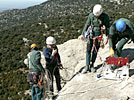 |
Rescuing specimens from nest with no or low productivityWith the collaboration of specialists from local and central Government, fertile nestlings at risk will be rescued from nests located in these identified territories and transferred to the Breeding Centrewith Human Isolation (CRIAH), in Zaragoza |
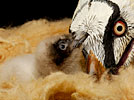 |
Human solation breeding protocolAt the Breeding Centre, the eggs are checkd and placed in an incubator until they hatch. The individuals are then raised using the protocol of natural umprinting in conditions of human isolation. Usin this method, the birds never have contacto with a person, since they are fed and reared using a puppet that simulates an adult bearded vulture. In this way human imprinting is avoided and their chance of success in the wild is similar to that of a bird fledged in the wild. |
 |
Behavioural learning by natural imprinting: hackingAfter the first stage at the Breeding Centre, the individuals are moved to cages that resemble nests in the wild, set on a platform located in Ordesa y Monte Perdido National Park facing an active feeding site. Here they develop the correct behavior in the presence of wild bearded vultures in their natural habitat. |
 |
Releasing in Picos the Europa National ParkWhen they are approximately three months old, the individuals are move to a pre-releasing facility in Picos de Europa National Park to continue the hacking process in the area where they will be released when they are around 120 days old. In this way the individuals become familiar with their surroundings so they get imprinted with the habitat that will become their home. |
 |
Monitoring and tracking of released birdsThe individuals are ringed, marked with patagial tags and equipped with solar powered GPS satellite and radio transmitters. The aim is to monitor these individuals as long as possible following their release, to determine the success of the release, check the condition of the birds and intervene if necessary. |
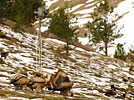 |
Adecuación de recintos para la eliminación de cadáveres de ganadoAn old feeding not currently in use will be re-activated in Picos de Europa National park, close to the release site, thereby establishing a permanent supplementary feeding point for the released birds. |
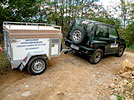 |
Creating an anti-poison patrolThe canine unit of Poison Detection of Principado de Asturias will perform 40 patrols every year to search for poisoned baits throughout the territories where the bearded vultures are being releases and others areas where the use of poison in suspected. |
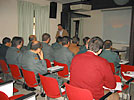 |
Training actionsA training programme will be developed for proffesionals involved in bearded vulture conservation in Pyrenees and Picos de Europa: farmers, sheperds, hunters, tourism operators, rangers, etc. |
| Back to index | |
|
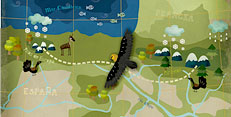
Red de Escuelas por |

EcoTurismo |
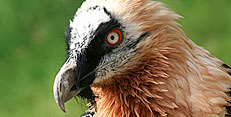
Conoce a nuestros |
|
MAS INFORMACIÓN
|
MAS INFORMACIÓN
|
MAS INFORMACIÓN
|
MAS INFORMACIÓN
|